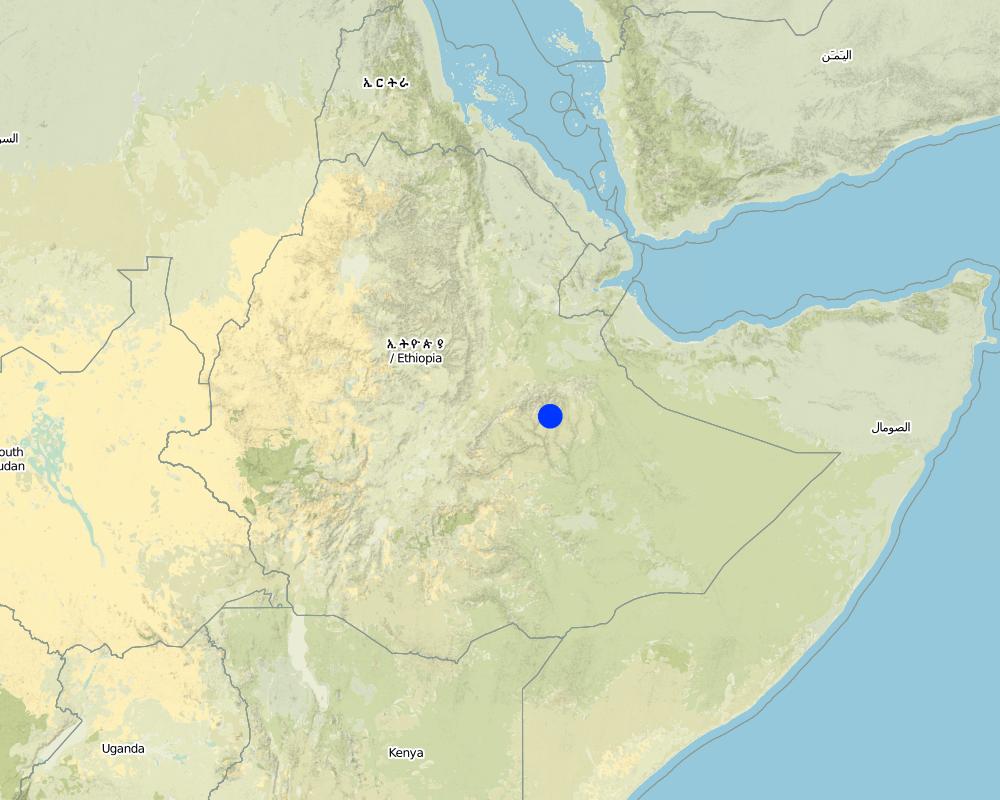Local Level Participatory Planning (LLPPA) [埃塞俄比亚]
- 创建:
- 更新:
- 编制者: Philippe Zahner
- 编辑者: –
- 审查者: Fabian Ottiger
approaches_2651 - 埃塞俄比亚
查看章节
全部展开 全部收起1. 一般信息
1.2 参与方法评估和文件编制的资源人员和机构的联系方式
有助于对方法进行记录/评估的机构名称(如相关)
Swiss Agency for Development and Cooperation (DEZA / COSUDE / DDC / SDC) - 瑞士1.3 关于使用通过WOCAT记录的数据的条件
编制者和关键资源人员接受有关使用通过WOCAT记录数据的条件。:
是
1.4 SLM技术问卷的参考

Stone faced level bund [埃塞俄比亚]
Stone faced bund is embankment constructed from stone & soil along the contour at upper part to reduce velocity of run of & length of slope with collection ditch in the uper part.
- 编制者: Unknown User
2. SLM方法的描述
2.1 该方法的简要说明
LLPPA
2.2 该方法的详细说明
该方法的详细说明:
Aims / objectives: To enhance people's (community) participation in planning implimentation and evaluation of SWC technologies., Changing farmers attifued towards current ecological concept and enable them to keep there agro-ecological environment by training and awaring them to utilize appropriat SWC technology in their farm and their vicinity, By group formation, At PA level, From planning the sWC technology in an area up to maintenance and stablization.
2.5 采用该方法的国家/地区/地点
国家:
埃塞俄比亚
区域/州/省:
W/Herergea
Map
×2.6 该方法的开始和终止日期
终止年份(若不再采用该方法):
1996
2.7 方法的类型
- 基于项目/方案
2.8 该方法的主要目的/目标
The Approach focused mainly on other activities than SLM (It increases soil fertility to plant forage on bund.)
Increasment of land productivity.
The SLM Approach addressed the following problems: Scarcity of land, poorness of the country, the consequence of the approach will be seen in the future.
2.9 推动或妨碍实施本办法所适用的技术的条件
法律框架(土地使用权、土地和水使用权)
- 启动
The existing land ownership, land use rights / water rights helped a little the approach implementation: There is no land use policy
了解SLM,获得技术支持
- 阻碍
Do not accepting technical design
Treatment through the SLM Approach: By teaching the farmers.
3. 相关利益相关者的参与和角色
3.1 该方法涉及的利益相关者及其职责
- 当地土地使用者/当地社区
Working land users were work equally divided between men and women but some activities are difficult to be carried out by women. Make group by consulting with female group.
3.2 当地土地使用者/当地社区参与该方法的不同阶段
| 当地土地使用者/当地社区的参与 | 指定参与人员并描述活动 | |
|---|---|---|
| 启动/动机 | 自我动员 | |
| 计划 | 自我动员 | |
| 实施 | 外部支持 | casual labour |
| 监测/评估 | 互动 | measurements/observations; |
| Research | 无 |
3.4 有关SLM技术选择的决策
具体说明谁有权决定选择要实施的技术:
- 主要是SLM专家,咨询土地使用者之后
解释:
Decisions on the method of implementing the SLM Technology were made by mainly by land users supported by SLM specialists
4. 技术支持、能力建设和知识管理
4.2 咨询服务
土地使用者有权使用咨询服务吗?:
是
说明/注释:
Name of method used for advisory service: T & U System; 1) Advisory service was carried out through: government's existing extension system, Extension staff: mainly government employees
Advisory service is quite adequate to ensure the continuation of land conservation activities
4.3 机构强化(组织发展)
是否通过这种方法建立或加强了机构?:
- 否
4.4 监测和评估
监测和评估是该方法的一部分吗?:
是
注释:
bio-physical aspects were monitored through observations
technical aspects were monitored through observations
economic / production aspects were monitored through observations
area treated aspects were monitored through observations
There were many changes in the Approach as a result of monitoring and evaluation: As a result of monitoring and evaluation the bunds are maintainced those can't fit the technical design are re-costructed.
5. 融资和外部物质支持
5.2 为土地使用者提供财政/物质支援
土地使用者是否获得实施该技术的财政/物质支持?:
是
5.3 对特定投入的补贴(包括劳动力)
- 农业
| 具体说明哪些投入得到了补贴 | 程度如何 | 对补贴做出具体说明 |
|---|---|---|
| Seedlings | 部分融资 | |
如果土地使用者的劳动力是一项重要的投入,那么是不是:
- 以粮换工
5.4 信用
是否根据SLM活动的方法给予信用值?:
否
6. 影响分析和结论性陈述
6.1 方法的影响
该方法是否帮助土地使用者实施和维护SLM技术?:
- 否
- 是,很少
- 是,中等
- 是,支持力度很大
Adopted group working system
该方法是否改善了阻碍SLM技术实施的土地使用权/用户权问题?:
- 否
- 是,很少
- 是,中等
- 是,支持力度很大
The problem is likely to be overcome in the near future. Because the land use policy may release in the near future.
Did other land users / projects adopt the Approach?
- 否
- 是,很少
- 是,中等
- 是,支持力度很大
6.3 方法活动的可持续性
土地使用者能否维持通过该方法实施的措施(无外部支持的情况下)?:
- 是
6.4 该方法的长处/优点
| 土地使用者眼中的长处/优势/机会 |
|---|
| Overcoming shortage of fuel wood and forage |
| Increase productivity |
| Decreasing the time spent for fetching water |
| 编制者或其他关键资源人员认为的长处/优势/机会 |
|---|
| To increase soil fertility (How to sustain/ enhance this strength: By increasing farmers awareness) |
| Reduce runoff (How to sustain/ enhance this strength: By increasing farmers awareness) |
| Increase forage availability (How to sustain/ enhance this strength: By increasing farmers awareness) |
| Increase fuel construction wood (How to sustain/ enhance this strength: By increasing farmers awareness) |
| Increas availability of clean water (How to sustain/ enhance this strength: By increasing farmers awareness) |
6.5 该方法的弱点/缺点以及克服它们的方法
| 土地使用者认为的弱点/缺点/风险 | 如何克服它们? |
|---|---|
| Decreasing cultivated land | Creating awareness |
| Addressing weeds |
| 编制者或其他关键资源人员认为的弱点/缺点/风险 | 如何克服它们? |
|---|---|
| No |
7. 参考和链接
7.1 方法/信息来源
- 实地考察、实地调查
- 与土地使用者的访谈
链接和模块
全部展开 全部收起链接

Stone faced level bund [埃塞俄比亚]
Stone faced bund is embankment constructed from stone & soil along the contour at upper part to reduce velocity of run of & length of slope with collection ditch in the uper part.
- 编制者: Unknown User
模块
无模块


